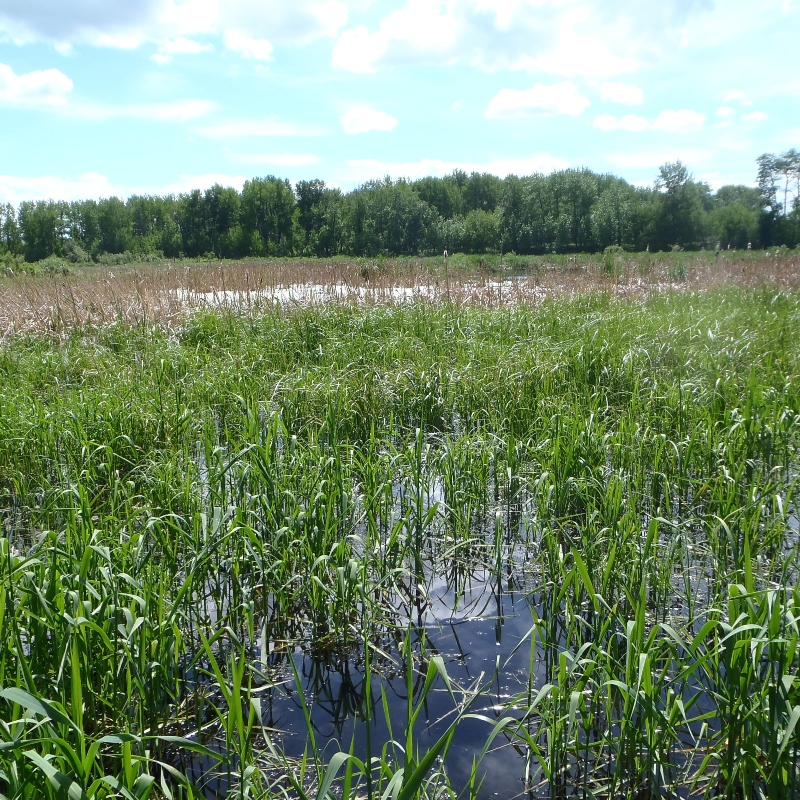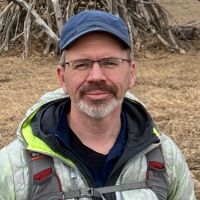Section 4.3
Methods Spotlight: Amphibian eDNA
Summary of the collection and analysis of environmental DNA, and monitoring results for four of Alberta's amphibian species


.jpg) Andrew DuBois
Andrew DuBois
Tiger Salamanders (Ambystoma mavortium) are difficult to survey, but can be detected through eDNA sampling.
- Environmental DNA (eDNA) refers to DNA fragments that organisms shed into the environment through tissue (e.g., skin, scales, waste). These fragments can be collected and analyzed to detect the presence of one or more species.
- The analysis of eDNA allows researchers to monitor species without having to collect or observe specimens directly, which can save time and money while reducing stress on target species.
- This project was initiated to develop protocols for collecting amphibian eDNA in open water wetlands, and to compare the detection ability of eDNA collection to that of methods currently in use.
Background
Environmental DNA (eDNA) refers to DNA fragments that organisms shed into the environment. These fragments can be collected and analyzed to determine what species are present.
Environmental DNA (eDNA) sampling is a new and promising method with the potential to increase the efficiency of monitoring a wide array of taxa. eDNA sampling may serve to complement or modernize some of our current sampling protocols by:
- detecting species without having to actually collect or observe specimens—this can reduce field time and the impact of field activities on target species and habitats,
- identifying the presence of species that are difficult to survey using other methods, including rare and elusive species,
- detecting species at any life stage (e.g., egg, larvae, adult), and
- providing more reliable trend data.
In the spring of 2020, we initiated a pilot project with InnoTech Alberta to explore the effectiveness of eDNA technology for monitoring amphibians in wetland habitats. The objectives of the project were to:
- develop field protocols to collect amphibian DNA in open water wetlands,
- develop and test DNA primers (short, species-specific DNA sequences) for target amphibian species, and
- compare the detection ability of eDNA to the current monitoring methods employed by the ABMI (autonomous recording units [ARUs]).

Amphibian eggs, such as these from a Tiger Salamander, can be detected in eDNA samples.
How is Environmental DNA Sampled?


Water samples are collected in the field and...

...DNA fragments are extracted and processed in the lab to identify species.
- A variety of habitat elements can be sampled to collect eDNA, such as water[1,2], flower petals[3] and topsoil[4,5]; we collected water samples in the pilot project.
- Once the environmental sample is collected, the DNA is extracted and matched to known species-specific DNA sequences (primers).
- Primers are either designed from genetic information published in previous work or held in public databases. Their functionality is tested and optimized using tissue from target species and assessed for specificity using DNA from non-target species by looking for cross reactions.
- Depending on the collection methods, eDNA can be used to answer questions about species occurrence[1,6,7] and the population structure of species and communities[8].
- To read more about eDNA sampling, see the field protocols developed for this project[9]. To read more about this project, see the final report[10] or this news article.
About This Study
We surveyed amphibian presence at four wetlands in the Edmonton area by collecting eDNA and sound recordings throughout the summer. The eDNA collection methods[9] used were based on those originally developed by Brian Eaton’s team at InnoTech Alberta.
eDNA typically occurs at low concentrations, and is variably distributed across both space (e.g., because of differential habitat use) and time (e.g., because of seasonal habitat use) throughout a waterbody[11]. Therefore, eDNA was collected in two ways to compare methods:
- Regular samples were collected by filtering 3-L water samples at three locations per wetland.
- At one site, composite samples were also collected. Composite samples—a modified collection method—involved collecting three 1-L samples in one general area. These composite samples were taken at three locations within the wetland.
The composite sampling layout is an adaptation developed in collaboration with InnoTech Alberta for this project. Its aim is to more thoroughly sample variable habitats in wetlands, increasing the chance for comprehensive eDNA capture.
We also sampled each wetland using one autonomous recording unit (ARU) to collect sound recordings throughout each 24-hour period. Amphibians were identified by their calls from a stratified random selection of the recordings from midnight to 2:00 AM throughout the summer. This time was chosen to coincide with peak times of amphibian calling.
Example sampling layout at wetlands including regular and composite eDNA sampling and ARU placement.
Results
Species Detected
We detected four amphibian species using ARUs and eDNA sampling:
| ARUs only | ARUs and eDNA | eDNA only |
|---|---|---|
|
Western Toad |
Boreal Chorus Frog Wood Frog |
Tiger Salamander (Ambystoma mavortium) |

Western Toad
- Western Toads were rare at the study sites, with one calling toad recorded by ARUs at one site.
- This species was not detected using eDNA at the same site.
- This result highlights one challenge with sampling eDNA in wetlands where amphibian abundance is low: if eDNA concentrations are too low or eDNA sampling occurs in the wrong spot, a species may not be detected.

Boreal Chorus Frog
- The eDNA approach was unable to pick up the Boreal Chorus Frog at three of the four sites where it was detected by ARUs.
- The eDNA primer development for this species proved tricky and the best performing primer did not exhibit good sensitivity.
- More work is required to develop a reliable primer.

Wood Frog
- Wood Frogs were reliably detected at all sites using both the eDNA and ARU methods of detection.

Tiger Salamander
- Tiger Salamanders were detected by eDNA methods at two sites, indicating that this may be an effective method to detect and monitor this species.
- ARUs cannot be used to monitor Tiger Salamanders because they do not call like frogs and toads.
Comparison of Sampling Methods
- The composite and regular methods of sampling eDNA generated similar results, suggesting that the composite sampling did not capture more DNA than the regular sampling procedure.
- However, this comparison was limited to one site and lacked replication, so a statistical comparison could not be performed.
 Amanda Schmidt
Amanda Schmidt
Conclusion
- This project revealed that eDNA is a valuable tool in the monitoring toolbox, and that the efficiency of using either method (eDNA or ARUs) depends on species-specific traits (e.g., density and distribution in wetlands) and site conditions.
- The results indicated that both monitoring methods had advantages depending on the target species.
- We are continuing to work with InnoTech Alberta to improve eDNA sampling methodologies for amphibians and are exploring DNA monitoring methods for macroinvertebrates and vascular plants.

References
Schmelzle, M.C. and A.P. Kinziger. 2016. Using occupancy modelling to compare environmental DNA to traditional field methods for regional-scale monitoring of an endangered aquatic species. Molecular Ecology Resources 16(4):895-908. Available at: https://doi.org/10.1111/1755-0998.12501
Stat, M., M.J. Huggett, R. Bernasconi, J.D. Dibattista, T.E. Berry, S.J Newman, E.S. Harvey, and M. Bunce. 2017. Ecosystem biomonitoring with eDNA: metabarcoding across the tree of life in a tropical marine environment. Scientific Reports 7(1):1-11. Available at: https://doi.org/10.1038/s41598-017-12501-5
Thomsen, P.F. and E.E. Sigsgaard. 2019. Environmental DNA metabarcoding of wild flowers reveals diverse communities of terrestrial arthropods. Ecology and Evolution 9(4):1665-1679. Available at: https://doi.org/10.1002/ece3.4809
Buée, M., M. Reich, C. Murat, E. Morin, R.H. Nilsson, S. Uroz, and F. Martin. 2009. 454 Pyrosequencing analyses of forest soils reveal an unexpectedly high fungal diversity. New Phytologist 184(2):449-456. Available at: https://doi.org/10.1111/j.1469-8137.2009.03003.x
O’Brien, H.E., J.L. Parrent, J.A. Jackson, J. Moncalvo, and R. Vilgalys. 2005. Fungal community analysis by large-scale sequencing of environmental samples. Applied and Environmental Microbiology 71(9):5544-5550. Available at: https://doi.org/10.1128/AEM.71.9.5544-5550.2005
Bohmann, K., A. Evans, M.T.P. Gilbert, G.R. Carvalho, S. Creer, M. Knapp, D.W. Yu, and M. de Bruyn. 2014. Environmental DNA for wildlife biology and biodiversity monitoring. Trends in Ecology and Evolution 29(6):358-367. Available at: https://doi.org/10.1016/j.tree.2014.04.003
Thomsen, P.F. and E. Willerslev. 2015. Environmental DNA—an emerging tool in conservation for monitoring past and present biodiversity. Biological Conservation 183:4-18. Available at: https://doi.org/10.1016/j.biocon.2014.11.019
Bohmann, K., S. Gopalakrishnan, M. Nielsen, L. dos Santos Bay Neilsen, G. Jones, D.G. Streicker, and M.T.P. Gilbert. 2018. Using DNA metabarcoding for simultaneous inference of common vampire bat diet and population structure. Molecular Ecology Resources 18(5):1050-1063. Available at: https://doi.org/10.1111/1755-0998.12891
Alberta Biodiversity Monitoring Institute. 2022. Open water wetland environmental DNA (eDNA) field collection protocols, 2022-03-29. Alberta Biodiversity Monitoring Institute. Available at: https://www.abmi.ca/home/publications/601-650/624
Dooley, J., S. Koziel, and B. Eaton. 2022. Amphibian eDNA pilot report. Alberta Biodiversity Monitoring Institute. Available at: https://www.abmi.ca/home/publications/601-650/623
Takahara, T., T. Minamoto, H. Yamanaka, H. Doi, and Z. Kawabata. 2012. Estimation of fish biomass using environmental DNA. PLoS ONE 7(4):e35868. Available at: https://doi.org/10.1371/journal.pone.0035868
Contributors

Dr. Jenet Dooley, Senior Wetland Ecologist, Alberta Biodiversity Monitoring Institute (ABMI)
Jenet has been working at the ABMI since February 2019. She leads varied wetland analysis and monitoring initiatives involving many wetland taxa, including amphibians.
If you have questions about the ABMI's wetland monitoring program, please get in touch: jenet.dooley@ualberta.ca

Dr. Brian Eaton, Manager, Environmental Impacts Team, InnoTech
Brian is an ecologist with 30+ years of experience in applied ecological research in terrestrial, wetland and aquatic systems. He has worked on a range of animal taxa, in settings ranging from aquaria to mesocosms to field studies. Brian and his colleagues have been exploring the use of eDNA to detect a range of species in aquatic systems in Alberta since 2016, and are expanding into terrestrial systems and community analysis.
If you have questions about InnoTech's eDNA program, please get in touch: brian.eaton@innotechalberta.ca





